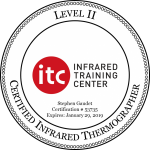Imagine you’re out camping on a cold night in your sleeping bag and your zipper breaks letting in all the cold. I’m sure you would do everything you could to fix it to stay warm. Now consider your home or the house your looking to purchase do not the same principles apply?

In fig I008 the perfect house, the entire exterior envelope is insulated reducing energy loss.
Presently oil prices are dropping which makes heating your home less expensive. However, at the peak of the recession 2009~2012 poorly heated homes were some of the first to go. Owners simply could not afford them and oil prices were soaring.
Based on the new 2014/15 Farmer’s Almanac we are headed for another cold winter. Here are some tips on possibly spotting a poorly heated or insulated home.
When reviewing thermal imaging photos, heat is seen in yellow, cold or water shows up as blue. There is a mixture of summer and winter photos I’ve taken this year.
Common myth, new homes do not have insulation problems. Not always true, see fig 1. Second-floor bedroom exterior wall abuts in attic space, missing insulation in the wall. Now this wall needs to be opened to install missing insulation.

Figure 2 another new home, thermal imaging shows missing insulation in attic space above. Roof was framed in before the insulation was installed, common practice. Insulation was overlooked because no one knew this open void existed until it was pointed out during the inspection.

Last new home should be ready to move in. As you’ll see in figures 3 and 4 this is not the case. Appears the builder missed a very important item, insulation in the attic, none to be found.

Most new homes come with a one year warranty. When the warranty expires any future repairs fall on to the buyer. Therefore, it is in your best interest to have a new home inspected prior to close.
Often first-time buyers fall into a trap of buying a less expensive older home not realizing insulation and heating problems exist. With older homes it’s what you can’t see that will cost you.
Figure 5 & 6 older home, IR photos taken in south facing bedrooms. Pay particular attention to temperature readings located in upper left corner of photos. Outside temperature was 95°, bedroom air temperature was above 100° due to lack of insulation in the walls.


Figures 7 & 8 show a 35 year old home with compressed insulation in the walls and attic space. Compressed insulation is a common problem with homes 30 years old and older. The insulation gets dried out and shrinks offering little to no insulation value. Note the temperature values recorded on the ceiling and wall. Compressed insulation less than 1” found in the attic space, 2×6 floor joists.


Windows & Doors
Older single pane windows can have loose fitting frames allowing heat loss. If you decide on replacement windows ask the version that was eligible for the energy tax credit, best option. If you can’t afford replacement windows consider Honeycomb Blinds.
Wood paneled doors often over looked as a source of heat loss. This photo shows a door on the North side (no sun exposure) of the home. Notice the temperatures recorded, exterior temperature at the time 95°. Solution install insulated doors.

Basements


Missing insulation on the perimeter of the foundation wall is very common. Often I find mice traps in the basement. Why? Mice pick up on heat loss. Home owners overlook they have a heat source in the basement, boiler or furnace releasing heat is attracting mice. Mice only need a hole the size of a dime to get in. Not insulating your basement makes your home a target.
If the home has a chimney fill the perimeter open voids between floor joists and chimney with rock wool fire resistant insulation. This will stop heat loss into the attic space and help slow down a fire racing through the structure.
New building codes now require an interior framed in door leading to the bulkhead. If you do not have one do so. Install an insulated door with frame, bulkheads with the slide bar lock offer no real security.

Attic
Check the levels of insulation in your attic space. If the insulation is level at or below the floor joists, you probably need to add more insulation. A good home inspector should report this level and R value. Newer homes should see R-48, not uncommon to see R30 in older homes. Look under the insulation, ideally you want a vapor barrier to slow down air leaks. If fiberglass batts are present they may have kraft paper faced (vapor barrier) attached. This type of insulation should be laid between the ceiling joists, paper facing down, which will help provide a slowing of the vapor movement.
There is one type of insulation you may not want, vermiculite which may contain asbestos commonly found in older homes. If you find it, recommend lab testing for asbestos.

Every house has a stack effect, warm air rises and a properly insulated attic will reduce your energy costs. Figure 13 shows some of the most common sources of heat loss into that attic space. If your attic is properly insulated air temperature should be close to exterior temperatures. During winter months examine your roof. Look for areas that have snow melt for no apparent reason, possible heat loss issue.

Heat loss can attract mice during winter months, heat with moisture can cause mold issues. Therefore, make sure if you have bathroom fans in the attic space they exhaust to the exterior. I’ve personally seen one bathroom fan not vented properly filled the attic space with mold.
Often in a poor performing insulated home you will find a second heat source such as a wood or pellet stove. An experienced home inspector using thermal imaging will know this is a red flag and point out insulation issues. Hiring a low cost inexperienced inspector may miss these flaws and it’s not their fault.
ASHI Standards of Practice States, 2.2 The inspector shall:
A. inspect readily accessible, visually observable, installed systems and components listed in this Standard.
So why is this important, after all the price of oil keeps falling? Let’s look back in history. In the mid 70’s we had low price gas and oil. Then we went into a recession and you could only get gas on odd and even days based on your license plate number. Big gas guzzlers and muscle cars were the first to go, followed by a drop in home prices and recession.
Fast forward to 2007~08, oil hits a high around $150/barrel. Housing market tanks due to price run up and over stock, economy slides into another recession. History repeating itself, first to go, poor performing cars, trucks and homes.
A home owner’s number one expense aside from the mortgage is paying the heating bill. One disruption in the economy or global advent can quickly affect fuel prices. Understand if your purchasing a home with low quality windows, doors and low insulation this will cost you money each and every month when it’s cold. If you already own a poor performing home invest the savings in fuel into your home while you can. If you do not know how your home is performing consider an energy audit.





